Nitrile VS Latex Coated Gloves: Which is Best?
When searching for work gloves, nitrile coated gloves, and latex coated gloves are popular options, but which is best? Before we begin with the merits, let's discuss the properties of latex and nitrile themselves. What is each substance made with, and what's its purpose? Does one fare better than the other? Find out.
The Pure Substances: Nitrile vs. Latex
On a basic level, nitrile is a synthetic rubber whereas latex is a natural material made from actual rubber. When using these gloves in their pure material (think stretchy - usually latex - gloves at the doctor's office) - not the coated kind - it’s important to know if you have an allergy to latex. If you do, then you must use an alternative to latex, but - either way - here are the advantages of pure nitrile gloves vs pure latex gloves.
The advantages of pure nitrile gloves:
They aren’t made with latex (for people with allergies) They are more puncture resistant They have a high sensitivity They mold to your hands They work well against infectious material They are chemical resistant They have a long shelf life For medical grade purposes, nitrile gloves are best if puncture resistance and chemical resistance are of concern.
The advantages of pure latex gloves:
They fit like a second skin They have high sensitivity They are long-wearing They are elastic They are biodegradable They work well for infectious materials They are inexpensive They are naturally chemicall resistant against acids, bases, chlorine, iodine, and formaldehyde. Latex gloves are most popular in the medical industry (as long as they're labeled medical grade), and act as a perfect barrier from bloodborne pathogens as well as other contaminants. They are also food safe, so work well for that industry, and for manufacturing.
However, what about nitrile and latex coated work gloves. Which is best then? Do the properties work the same in coating as they do as a singular product?
Before we get into the answer, it’s important to note that there are four types of palm coating for work gloves: PVC-coated, Polyurethane-coated, Latex-coated, and Nitrile palm-coated. Each have their merits, and which you choose will, ultimately, depend on purpose. Let's get into the uses of each.
The four types of palm-coated work gloves
Before weighing in on which is 'best,' let's take a look at the four types of palm-coated work gloves, and their purposes.
Nitrile-Coated Work Gloves
Nitrile-coated gloves are puncture, cut, snag, abrasion, oil, fuel, and tear resistant - three times more puncture resistant than rubber. Nitrile stands up well to oil unlike rubber. Nitrile isn’t flame resistant, but does well in a range of temperatures: between -4°C (25°F) and 149°C (300°F). Nitrile can be turned into a foam with sponge-like properties, sucking up oil on the surface of an object, and improving grip. It’s a good choice for jobs working with oily parts like in metal stamping.
Portwest Flexo Grip Nitrile Gloves
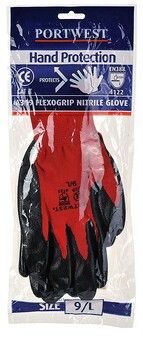
£0.56 per pair
Portwest Green Cut 5
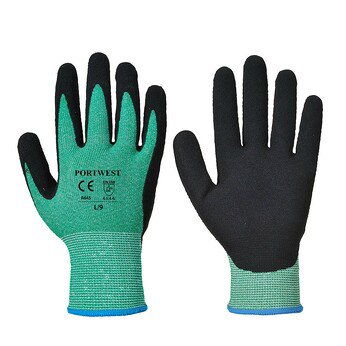
£3.77 per pair
Portwest DermiFlex Ultra +
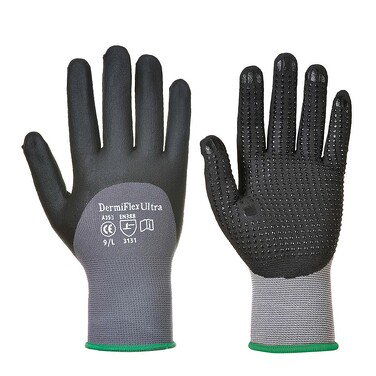
£1.92 per pair
Portwest Nitrile Knitwrist
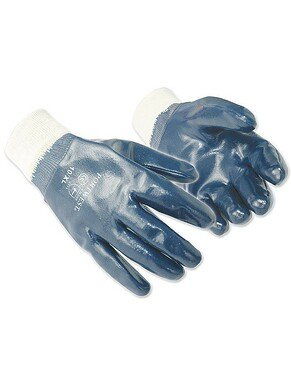
£1.13 per pair
Latex-Coated Work Gloves
Latex-coated work gloves, in contrast, have a high elasticity (stretch), and superior grip to any of the other materials. It can withstand high temperatures, and resist tears too. Latex resists alcohols, some ketones, but doesn’t resist hydrocarbon or organic solvents like gasoline. The downside is that many people are allergic to latex.
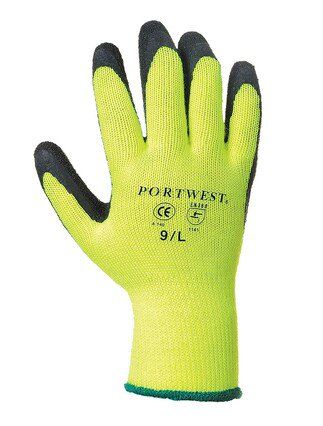
Portwest Thermal Grip Glove £1.57 per pair Portwest Fortis Grip Glove
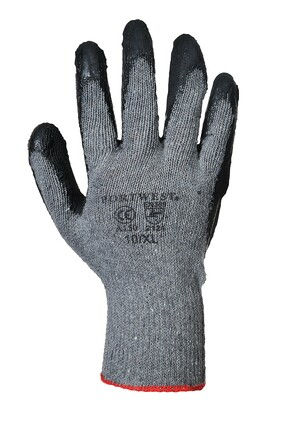
£0.54 per pair
Since our focus is on the two latter options, a quick definition of the other two options is sufficient.
PVC-Coated Work Gloves
A PVC-coated work glove is an inexpensive synthetic material that doesn’t cause allergic reaction. It’s stronger than latex or nitrile. It’s abrasion resistant but susceptible to punctures, cuts, and snags.
It is flexible, but doesn’t provide sensitivity to the touch unlike many rubber products. Its wear and abrasion resistance mirrors nitrile, but the benefit is glue will not adhere to it, so this type of glove is best for glue-related jobs like woodworking, automotive assembly, and trim application. It stays flexible in a lower temperature too, so it’s ideal as a winter glove.
Portwest Weatherproof Hi Vis Glove
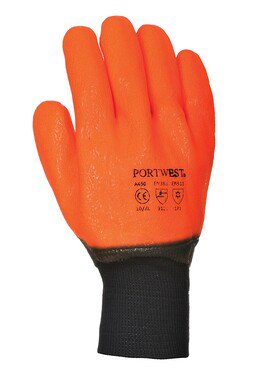
£3.25 per pair
Portwest PVC Gauntlet 45cm
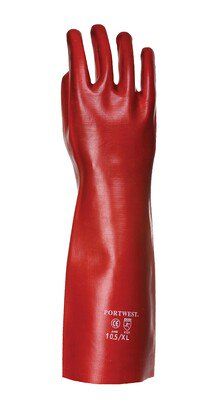
£1.75 per pair
Portwest Criss Cross Glove
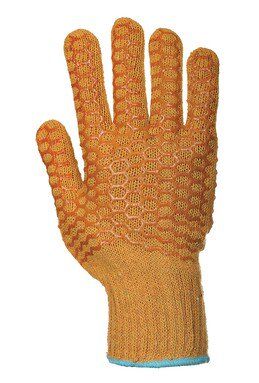
£0.72 per pair
Portwest Thermolite® Polka Dot Glove
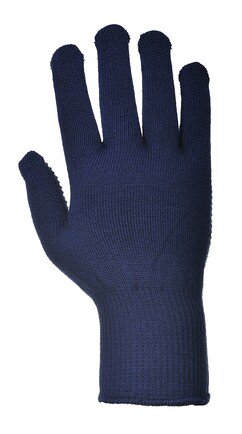
£1.85 per pair
Portwest PVC Knitwrist
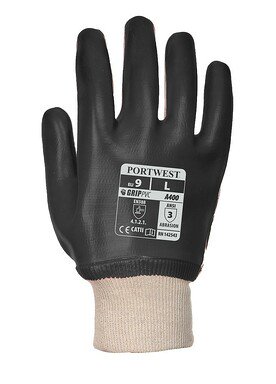
£0.60 per pair
Polyurethane-Coated Work Gloves
Polyurethane-coated work gloves, on the other hand, have great stretch and strength, and have a low particulate shed. This type of glove has recently seen more use in the medical industry on medical equipment for its low-allergic reaction causing properties. This material has a strong, non-sticky grip so it doesn’t need powder to reduce stickiness - like some rubber products. The material is soft with puncture and abrasion resistance, and it’s very versatile overall.
It’s used mostly to provide cut-resistance, and it still allows for sensitivity. It works well for electronic and cleanroom industries. It’s resistant to oil, solvent, fat, grease, gasoline (unlike rubber), oxidation, and ozone, but is not resistant to hot water, and shouldn’t be used above 79°C (175°F).
Portwest PU Palm Glove
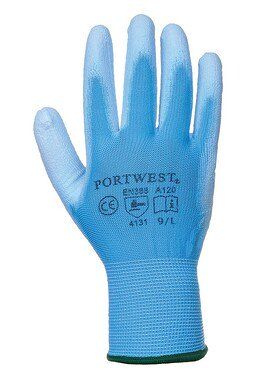
£0.35 per pair

Portwest Cut 5 PU Palm Glove
£3.04 per pair
So which should I choose?
Again, what you choose depends on your task and industry; however, for safety purposes, it’s best to find the highest-quality glove you can afford. Buying cheaper alternatives can lead to injury, and higher replacement rate, so whether you’re choosing between nitrile and latex or polyurethane and PVC is really up to you and your industry. For example, if you want to resist high temperatures and have a good grip, latex should be your choice, but if you want to have the best puncture resistance, you’d choose nitrile. For glue-working industries, PVC coating would be the best fit (no pun intended), and for its low shed, cut-resistance, grip, and low allergen properties polyurethane (PU) coating wins. There’s no right answer on what to choose, but your hazard report should provide insight into what will work for your industry.
At Xamax, we have all four of these coatings available in our work gloves with different PPE specifications and price points. Find out which glove is right for you:
Make sure you’re prioritising worker safety.
At Xamax, we aim to keep you safe by providing top quality products at a price that can’t be beaten (talk to our sales team if you find a product cheaper anywhere else - and we’ll match your price). Download your FREE copy of our PPE checklist today so you can find out if you’re PPE compliant. You’ll know when to reorder equipment, how to take care of it, how to store it, how to clean it, and much more.
- How Long Does PPE Last? (Probably Not As Long As You Think) - 12th March 2025
- BSIF Issues Urgent Warning: 90% of PPE from Non-Registered Providers Fails Safety Tests (2025) - 10th February 2025
- Understanding UK Safety Standards for Respiratory Protection - 14th October 2024






